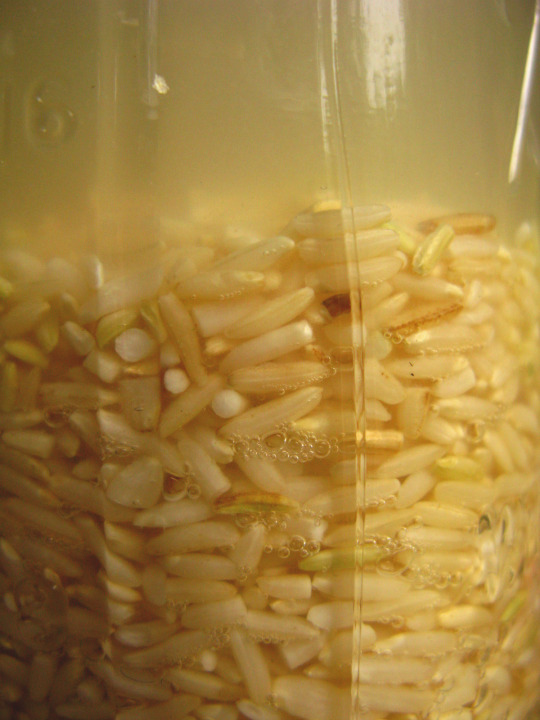Rice fermentation, easy.

Rice is a staple food in many countries, and often there are strategies for opening up the nutritional content, and reducing the anti-nutrient qualities. Often, elimination diets call for the removal of all grains from the diet, with each grain being reintroduced separately, and any reactions noted. With all grains, I recommend reintroducing them in an activated or fermented form first, and then if no reaction is noted, in an unmodified form.
The key anti-nutrient in rice is phytic acid. Phytic acid, or phytate is the storage form of phosphorous in grains, seeds, nuts, and legumes, and has been shown to block the absorption of key minerals from foods. For example, a study published in the American Journal of Clinical Nutrition in 2003 found that phytic acid reduction in rice led to a 309% increase in iron absorption. Other minerals with poor absorption due to phytic acid are calcium, zinc, and magnesium. The mineral blocking action only applies to current intake; phytic acid doesn’t affect later meals. Mineral deficiency in meat eaters is not generally a concern if a good diet is followed, but people who eat little or no meat may develop deficiencies if a lot of unmodified grains, seeds, legumes, and nuts are eaten.
There is research existing that phytic acid may have some benefits, including an anti-cancer action, and reduction in kidney stones. That said, if the diet is already rich in functional and medicinal foods, this action is not essential, and reduction of phytic acid may be better overall. The strategies for reducing phytic acid are soaking, sprouting, and fermentation, either separately, or in any combination. Soaking, sprouting and fermentation of quinoa, for example, can reduce the phytic acid content by 98%. If you think you would like to soak and ferment your rice, read on.
Soak brown rice for 24 hours in unchlorinated water. Drain it, reserve 10% of the soaking liquid, and keep this in a jar in the fridge. Next time you soak your rice, add the 10% of reserved soaking liquid to the new batch. Drain, reserve 10 %, keep it in the fridge, and so on. By the time you have done this 4 times or so (with four successive batches of rice), most of the phytic acid within the rice will be broken down, it will be more nutritionally open, and more digestible. Basically, each ferment builds up the level of micro-organisms in the soaking liquid, which comes into its full power after about 4 ferments. Rice is also fermented with various mould and bacteria combinations for other foods, but these involve specific cultures. There is also fermentation of cooked rice, popular in some Asian countries, which uses yeast and sometimes a little sugar. Add yeast and sugar to cooked rice; it’s done when a brownish liquid starts appearing in the bottom of the bowl.
Have you considered germinating your rice? There is a complex 24 hour method, but the easy long 2-3 day soak is best. Change the water a few times over the course of the soaking. The end of the grain will bulge and discolour as it begins to germinate. Germinated grains may then be fermented as well.
The water from soaked and fermented raw rice grains is utilised in the traditional Chinese cabbage ferment known as Suan Cai.